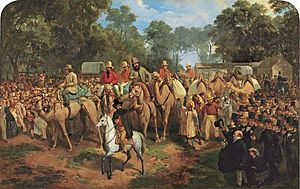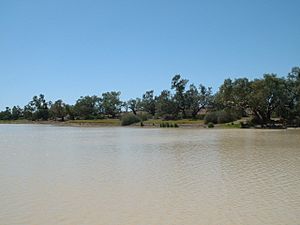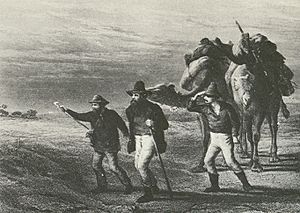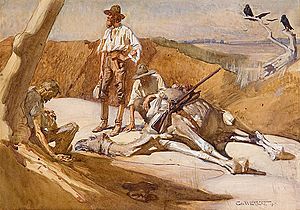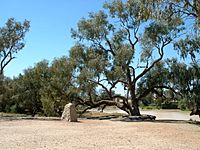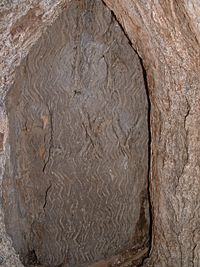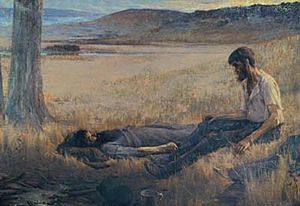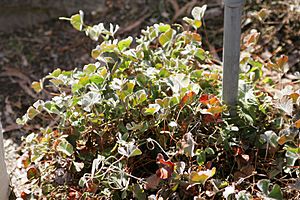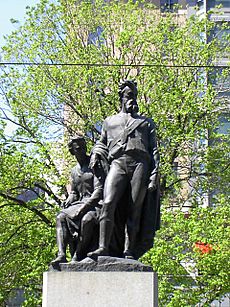Burke and Wills expedition facts for kids
The Burke and Wills expedition was a huge journey across Australia. It was led by Robert O'Hara Burke and William John Wills. They wanted to cross Australia from south to north. The group left Melbourne on 20 August 1860. They reached the Gulf of Carpentaria on 9 February 1861. But, because of bad planning and leadership, Burke and Wills sadly died. They ran out of food at Cooper Creek on their way back.
Contents
Why the Expedition Happened
In 1851, gold was found in Victoria. This started a big gold rush. Many people moved to Victoria. Melbourne quickly became Australia's largest city. It was also the second largest city in the British Empire. This made Victoria very rich.
People started thinking about how to connect Australia to Europe by telegraph. This would be a very long wire carrying messages. Different parts of Australia wanted the telegraph line to go through their area. This would bring them money and importance. The government of Victoria decided to send the Burke and Wills expedition. Their goal was to find a route across the continent.
Who Organized the Journey
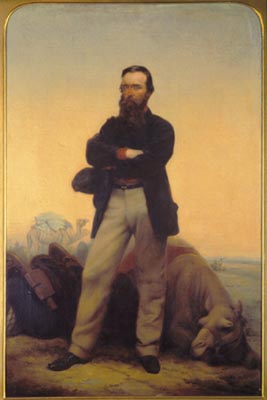
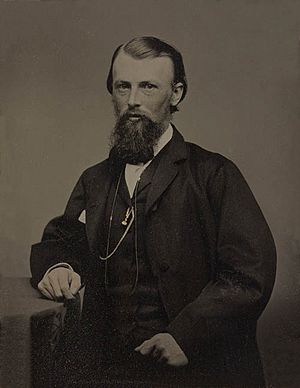
In 1857, a group called the Exploration Committee was formed. They wanted to plan a big journey into Australia's unknown lands. It took a few years to raise enough money.
The Committee chose Robert O'Hara Burke to lead the expedition. William John Wills was chosen as the surveyor and second-in-command. Burke had no experience exploring the wilderness. He was a police superintendent. Wills was better at living in the bush. But Burke's choices often caused problems for the mission.
The Committee decided to take dried meat instead of live animals for food. This meant they needed three extra wagons. This made the journey much slower.
Camels for the Desert
Camels had been used in deserts around the world. In 1859, only seven camels were in Australia. The government bought 24 more camels from India. Six more were bought from a local garden. These animals arrived in Melbourne in June 1860.
Twenty-six camels went on the expedition. Six camels stayed behind in Melbourne. Camels were important for carrying heavy loads in the desert.
Starting the Big Trip
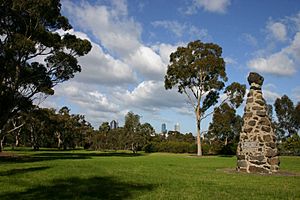
The expedition started from Royal Park, Melbourne on 20 August 1860. About 15,000 people watched them leave. There were 19 men in the group. They had 23 horses, 6 wagons, and 26 camels.
They carried a lot of equipment. This included enough food for two years. The total weight was about 20 tonnes. One wagon broke down before they even left Royal Park. Heavy rains and bad roads made travel very hard.
They reached Menindee after two months. This journey usually took only a week by mail coach. By this time, two of the main officers had quit. Many men had been fired, and new ones hired.
Burke was worried another explorer might reach the north coast first. He decided to split the group. He took the strongest horses and seven men. They would go quickly to Cooper Creek and wait for the others. They left Menindee on 19 October. Travel was easy at first because of recent rain. But Burke sent William Wright back to Menindee for more supplies. Burke continued to Cooper Creek.
At Cooper Creek
In 1860, Cooper Creek was the edge of explored land. Burke arrived there on 11 November. They set up a main camp. They called it Fort Wills.
Burke was expected to wait at Cooper Creek until the cooler autumn months. But he decided to rush to the Gulf of Carpentaria. He split the group again on 16 December. He left William Brahe in charge of the camp. Burke, Wills, John King, and Charles Gray went north. They took six camels, one horse, and only three months of food. It was mid-summer, and temperatures were very hot. Wills secretly told Brahe to wait for four months, not three.
Reaching the Gulf
The journey north was easy, except for the heat. They found water easily. The Indigenous Australians they met were friendly. On 9 February 1861, they reached the Little Bynoe River. This was close to the ocean. But thick mangrove swamps stopped them from reaching the sea. They were very low on supplies. They had food for 27 days, but the trip had already taken 59 days.
On the way back, the wet season began. Heavy tropical rains started. They had to abandon or eat their camels and their only horse, Billy. They left equipment behind as their animals died.
To survive, they ate a plant called portulaca. Gray also caught and they ate an 11-pound python. Both Burke and Gray became sick with dysentery. Gray died on 17 April. The three remaining men were very weak from hunger and tiredness. They finally reached Cooper Creek on 21 April. But the camp was empty.
Back at Cooper Creek
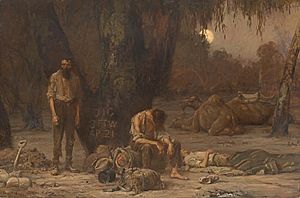
Burke had told Brahe to wait for 13 weeks. Brahe's group had waited for 18 weeks. They were low on supplies and getting sick. They thought Burke would not return. Brahe decided to go back to Menindee. Before leaving, he buried some supplies. He also carved a message on a tree to mark the spot.
Brahe left the camp on the morning of 21 April 1861. Burke, Wills, and King returned that evening. They found the camp empty. They dug up the hidden supplies. They found a letter saying the party had left. Burke's team had missed them by only nine hours. The three men and two camels were exhausted. They could not catch up to the main group.
They decided to rest and eat the buried supplies. Wills and King wanted to go back the way they came. But Burke decided to try and reach a cattle station far to the southwest. This meant traveling 240 km through the desert. They wrote a letter about their plan. They reburied it under the marked tree. But they did not change the mark on the tree or the date.
Meanwhile, Brahe met William Wright on his way back to Menindee. Wright was bringing more supplies. They both went back to Cooper Creek. They arrived on 8 May. Burke had already left. The camp was empty again. Brahe and Wright thought Burke had not returned. They did not check the buried supplies. They left to rejoin the main group.
The Dig Tree
The famous tree at the camp on Cooper Creek is a coolibah tree. It is about 250 years old. Brahe carved a message on it to show where the supplies were buried. This tree is now known as the "Dig Tree."
There are three carvings on the tree. One shows the camp number. Another shows the dates of arrival and departure. The third is the instruction to "DIG." Only the camp number is still clearly visible today.
Burke, Wills, and King Alone
After leaving the Dig Tree, they traveled very slowly. Their last two camels died. Without animals to carry water, they could not leave Cooper Creek. Their food was running out. They were very weak and hungry.
The local Indigenous Australians, the Yandruwandha people, helped them. They gave them fish, beans, and a type of bread. This bread was made from a plant called nardoo. In return, the explorers gave them sugar.
At the end of May, Wills went back to the Dig Tree. He put his diary and notes in the hidden supplies for safekeeping. Burke was angry at Brahe in his journal for not leaving more supplies. While Wills was away, Burke shot his pistol at one of the Aboriginal Australians. This made the whole group of Yandruwandha people leave. Within a month, Burke and Wills both died.
Their Deaths
Towards the end of June 1861, Wills became too weak to go on. He stayed behind with some food and water. Burke and King continued for two more days. Then Burke became too weak and died. King stayed with Burke's body for two days. Then he went back to Wills. He found that Wills had also died.
The exact dates of their deaths are not known. But it is generally thought they died around 28 June 1861. King found another group of Yandruwandha people. They gave him food and shelter. King helped them by shooting birds.
Rescue Missions
Six different groups were sent to find Burke and Wills. Some went by sea to search the Gulf of Carpentaria. Others started from different parts of Australia.
The first rescue team was led by Alfred William Howitt. He left Melbourne on 26 June 1861. On 3 September, his team reached Cooper Creek. On 15 September, they found King. He was living with the Yandruwandha people. King was the only survivor of the four men who went to the Gulf.
Over the next nine days, Howitt found the bodies of Burke and Wills. He buried them. King was very sick. He survived the two-month trip back to Melbourne. But he never fully recovered his health. He died eleven years later at age 33.
Other rescue expeditions also explored new areas of Australia. One team, led by William Landsborough, crossed Australia from north to south. They won a £2000 prize for this achievement.
Thanking the Yandruwandha People
Later, Howitt went back to Cooper Creek to bring Burke and Wills' bodies to Melbourne. On this trip, he gave special breastplates to the Yandruwandha people. These plates were a thank you from the Victorian Exploration Committee. They were given "for the Humanity shewn to the Explorers Burke, Wills and King 1861." One of these plates is now in the National Museum of Australia.
Why They Died
The explorers ate bread made from the nardoo plant. What they did not know was that nardoo contains a substance that removes vitamin B1 from the body. The local Aboriginal people knew how to prepare nardoo safely. But the explorers probably did not prepare it correctly.
Even though they were eating, the men became weaker and weaker. Wills wrote in his diary that he was "nearly skin and bone." He felt very weak and could barely move.
It is believed that Burke and Wills died partly from a vitamin deficiency disease called beriberi. This is caused by a lack of vitamin B1. They may also have suffered from scurvy, which is a lack of vitamin C. Other things like the harsh environment also played a part in their deaths.
What Happened Next
The Victorian Government held an investigation into the deaths of Burke and Wills. Howitt brought their bodies back to Melbourne. They were given a big state funeral on 21 January 1863. About 40,000 people came to watch. Burke and Wills were buried in the Melbourne General Cemetery.
Even though it was a sad story, the expedition was not a complete waste. It helped people understand more about the inside of Australia. It also showed that there was no big inland sea. The rescue missions also helped explore new parts of the continent.
Monuments were built in many towns to remember Burke and Wills. In 1890, a monument was put up in Royal Park, Melbourne. This was where the expedition started. It says that the brave leaders died on their return journey.
In 1983, their portraits were put on an postage stamp in Australia. In 2010, four more stamps were released for the 150th anniversary. Movies and coins have also been made to remember their journey.
Images for kids
See also
 In Spanish: Expedición de Burke y Wills para niños
In Spanish: Expedición de Burke y Wills para niños


